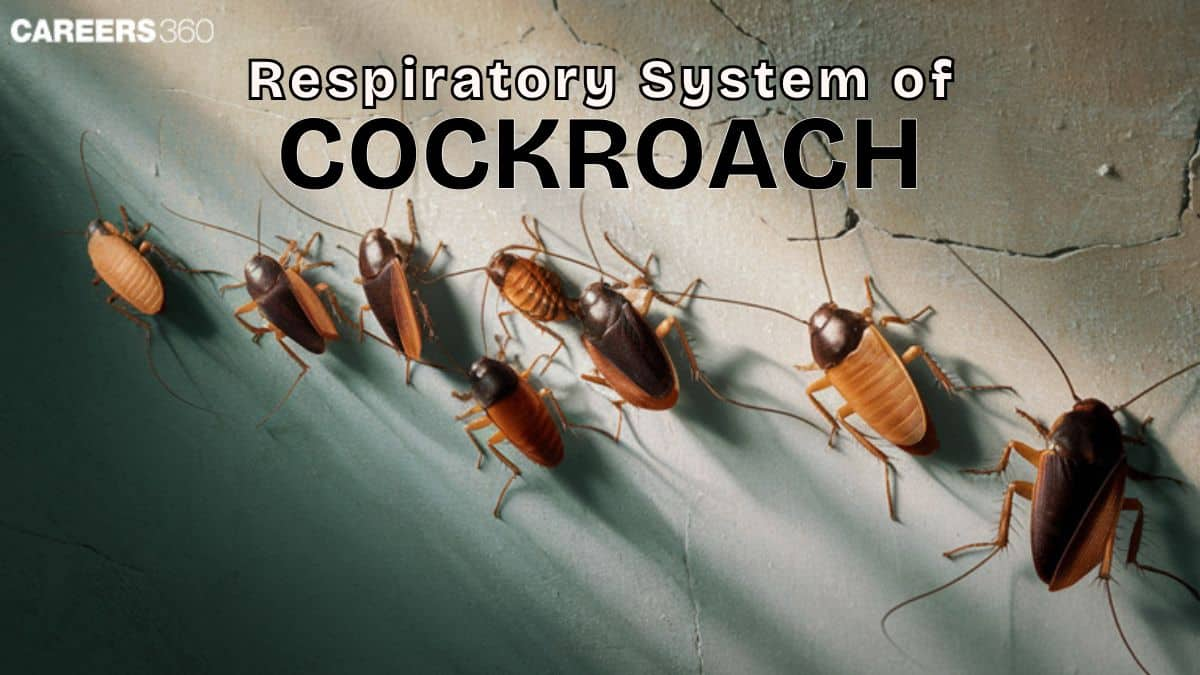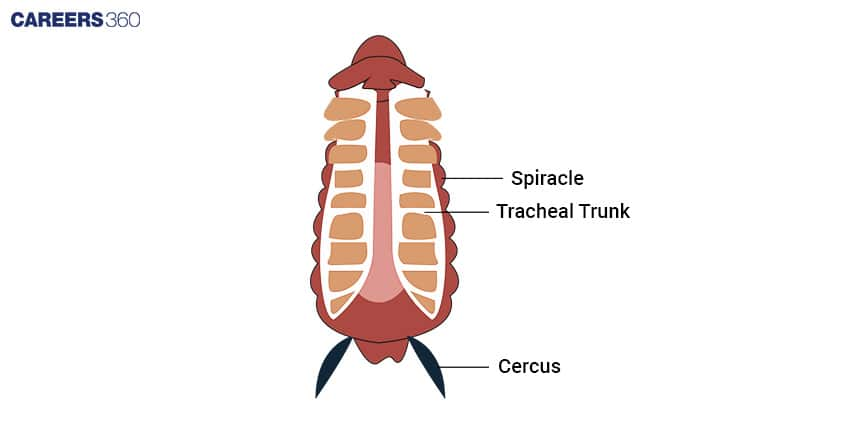Respiratory System Cockroach
The respiratory system of cockroaches consists of a tracheal network made up of spiracles, tracheae, and tracheoles. Through this system, oxygen is delivered directly to body cells, and carbon dioxide is removed, without the involvement of blood. This direct exchange makes respiration in cockroaches highly efficient. It is an important NEET and Class 11 Biology topic.
This Story also Contains
- What is the Respiratory System of Cockroach?
- Anatomy Of The Respiratory System In Cockroaches
- Mechanism of Respiration in Cockroach
- Role of Hemolymph in Cockroach Respiration
- Adaptation For Survival
- Comparison of Cockroach and Human Respiration
- Respiratory System of Cockroach NEET MCQs (With Answers & Explanations)

What is the Respiratory System of Cockroach?
The respiratory system of cockroach is well developed and elaborate to compensate for the absence of respiratory pigment in the blood. It consists of a system of air tubes or tracheae through which every tissue of their body remains in direct contact with the air for gaseous exchange. The air enters and exits from the tracheae through the spiracles.
Anatomy Of The Respiratory System In Cockroaches
The cockroach's respiratory system is efficient and specially adapted for land life. Much of it consists of the tracheal system, a complex network of tubes that convey oxygen directly to tissues and organs. This is a representative of an insect breathing mechanism and thus places cockroaches at an advantage to proliferate in many environments.
Spiracles (Number, Structure, Control)
There are ten pairs of spiracles or stigmata arranged segmentally, 2 pairs in the thorax and 8 pairs in the abdomen.
Each spiracle is a slit-like aperture guarded by bristles or hairs to prevent the passage of dirt.
The spiracles are opened and closed by valves regulated by sphincter or spiracular muscles.
This mechanism prevents undue loss of water through the spiracles and also regulates the flow of the air through them.
The aperture of each spiracle leads internally into a short chamber called atrium from which arises the main tracheal trunk.
Tracheae (Large Tubes)
The haemocoel of cockroach contains a system of network of elastic, close branching and silvery white tubes called tracheae.
The tracheae are formed by the pushing of the ectoderm. Hence, its wall consists of three layers: taenidia or intima, basement membrane and epithelium.
The intima is the cuticular lining which prevents the tracheae from collapsing.
Tracheoles (Fine Tubes Reaching Cells)
The ultimate branches of tracheae end in tracheole cells from which arise very fine tubes called tracheoles.
The tracheoles have thinned cuticle lining and they end blindly in the tissue cells.
In a resting insect when respiratory activity is not high, the tracheoles are filled, not with air but with a tissue fluid of cells in which oxygen dissolves.

Mechanism of Respiration in Cockroach
Respiration in cockroaches involves the intake, distribution, and exchange of gases. It is a very complex process.
Inhalation and Air Distribution
Air is inhaled through spiracles.
These spiracles form the entrance into large tracheal tubes.
The tracheal tubes divide into smaller and smaller tubes called tracheoles.
Through these tracheoles, the air diffuses directly into the body cells.
Gas Exchange at Cellular Level
Gas exchange in cockroaches occurs at the cellular level through direct diffusion using the tracheal system
Cells have oxygen from the tracheoles.
Carrying carbon dioxide in the direction of the tracheoles.
Driven by concentration gradients, the opening and closing are regulated to control the amount of air that passes through.
During dry conditions when the rate of evaporation is high, they close themselves to prevent loss of water from the body.
Spiracle Regulation
The tracheal tubes and tracheoles make up the foundation of the cockroach's breathing apparatus, allowing for excellent gas exchange.
Structure and Function of Tracheal Tubes
Large, air-filled tubes that come off the spiracles
Anastomose into smaller and finer tubes to increase surface area
Provide a pathway for the air to reach deeper tissues
Description of Tracheoles
Very fine tubes off the tracheal tubes.
Reach individual cells for direct gas exchange.
Contain fluid at the tips to oxygen for diffusion.
Role of Hemolymph in Cockroach Respiration
Hemolymph is a colorless fluid that serves as the blood of the insect. The hemolymph of cockroaches does not have any gas transport. It largely transports nutrients and carries waste products. It also keeps the cellular activity that allows support of the tracheal delivery system.
Adaptation For Survival
Cockroaches have adapted to survive in different environments.
Prevention of Water Loss
Spiracles are closed most of the time to prevent water loss. The spiracles can be closed preventing water loss in a controlled way.
Tolerance to Low Oxygen Environments
The extensively branching tracheal system allows for efficient oxygen delivery.
Tolerance to High CO2 Levels
Low oxygen environments can be tolerated by lowering the metabolic rate. High CO2 environments can be tolerated due to the effectiveness of their tracheal system.
Survival Underwater
Some species can close their spiracles for a prolonged period and stay underwater.
Comparison of Cockroach and Human Respiration
Different organisms have evolved specialized respiratory systems. While humans use lungs for respiration, cockroaches have tracheal systems. Let’s take a look at the differences between the respiratory systems of the two.
Cockroach Respiratory System | Human Respiratory System |
Respiration occurs via a system of spiracles and tracheae. | Respiration relies on complex system consisting of lungs, bronchi and alveoli. |
Spiracles act as opening for gas. | Nostrils act as opening for gas. |
There is no connection between the respiratory and circulatory system for exchange of gases. | Oxygen diffuses into the blood vessels and is tranported thorugh the body by red blood cells. |
Respiratory System of Cockroach NEET MCQs (With Answers & Explanations)
Important topic for NEET exam are:
Anatomy of the respiratory system (Spiracles, tracheae, tracheoles)
Mechanism of Respiration
Role of Hemolymph
Practice Questions for NEET
Q1. In cockroach, air from atmosphere enters by
Trachea
Tracheoles
Spiracles
Chitin
Correct answer: 3) Spiracles
Explanation:
The respiration in cockroaches takes place through the trachea, which opens through 10 pairs of small holes called spiracles (2 pairs of thoracic and 8 pairs of abdominal) `
- wherein
Spiracles are further subdivided into Tracheoles from air to all the parts. The exchange of gases takes place at the tracheoles by diffusion.
Hence, the correct answer is option 3) Spiracles.
Q2. Respiratory movement in cockroach is coordinated by
Autonomous system
Nerve centres in thoracic ganglia
Myogenic centres in thoracic ganglia
Any two of them
Correct answer: 2) Nerve centres in thoracic ganglia
Explanation:
Tracheal Ventilation: It is the airflow within the tracheal system, which mainly results from the contraction and relaxation of abdominal muscles also known as tergo-sternal muscles. This process is perfectly regulated and coordinated at the nerve centres located in the thoracic ganglia. This facilitates proper ventilation within organisms like insects to keep optimal oxygen levels, and carbon dioxide is expelled by the tracheal system.
Hence, the correct answer is Option 2) Nerve centres in Thoracic ganglia.
Q3. Assertion: The blood in a cockroach lacks a respiratory pigment and appears colorless.
Reason: Gaseous exchange in cockroaches takes place solely through diffusion in the hemolymph.
If both the assertion and reason are true, with the reason providing a correct explanation for the assertion.
If both the assertion and reason are true, but the reason does not adequately explain the assertion.
If the assertion is true, but the reason is false.
If both the assertion and reason are false
Correct assertion: 3) If the assertion is true, but the reason is false.
Explanation:
The assertion that the blood in a cockroach lacks a respiratory pigment and appears colorless is true. Cockroaches have an open circulatory system, and their blood is known as hemolymph. It does not contain respiratory pigments like hemoglobin, resulting in a colorless appearance. However, the reason provided, stating that gaseous exchange occurs solely through diffusion in the hemolymph, is false. In cockroaches, the gaseous exchange also takes place through a specialized network of tubules called tracheae, which allow direct air exchange with tissues.
Hence, the correct answer is option (3) If the assertion is true, but the reason is false.
Also Read:
Frequently Asked Questions (FAQs)
The major role of spiracles in cockroaches is, therefore, the regulation of entry and exit of air in such a way that efficient gas exchange occurs while water loss is at a minimum.
Cockroaches can exchange gases through a system of tracheal tubes and tracheoles, allowing for the direct delivery of oxygen to the cells and the removal of carbon dioxide without the use of the lungs.
These entail the growth of spiracles that shut to avoid loss of water, a highly branching tracheal system for efficient delivery of these gases, and the ability to decrease metabolic rates when the availability of oxygen is low.
Unlike humans, who use lungs and a circulatory system to transport gases, cockroaches have a network of tracheal tubes which provide for direct gas exchange with the cells. Hence, their system is more direct and less dependent on circulatory transport.
Most of the strategies in pest control involve an attack on the respiratory system of the cockroach by using chemicals that block spiracles or disrupt the tracheal system, thus leading to suffocation, which causes subsequent death.